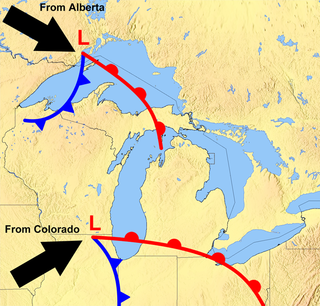
The Great Lakes Storm of 1913 was a blizzard with hurricane-force winds that devastated the Great Lakes Basin in the Midwestern United States and Southwestern Ontario, Canada, from November 7 to 10, 1913. The storm was most powerful on November 9, battering and overturning ships on four of the five Great Lakes, particularly Lake Huron.

Lake freighters, or lakers, are bulk carrier vessels that operate on the Great Lakes of North America. These vessels are traditionally called boats, although classified as ships.

USCGC Mackinaw (WAGB-83) is a 290-foot (88 m) former Coast Guard icebreaker on exhibit as a museum ship at the Icebreaker Mackinaw Maritime Museum in Mackinaw City, Michigan. The vessel has been known as the "Queen of the Great Lakes" and "The Largest Icebreaker on the Great Lakes"; the site states that "she was built during World War II to meet the heavy demands of war materials and transportation during the winter months".

USCGC Bramble (WLB-392) is one of the 39 original 180-foot (55 m) seagoing buoy tenders built between 1942 and 1944 for the United States Coast Guard. In commission from 1944 until 2003 she saw service in Pacific, Caribbean and Atlantic waters as well as the Great Lakes. In 1947 Bramble was present at the Nuclear testing at Bikini Atoll and in 1957 a circumnavigation of North America involved a forced traverse of the Northwest Passage. After decommissioning in 2003 Bramble became a museum ship in Port Huron, Michigan. In 2018 she was sold to a private owner, who is preparing MV Bramble to repeat her historic 1957 circumnavigation of North America.

The SS Regina was a cargo ship built for the Merchant Mutual Line and home ported in Montreal, Quebec. Named after Regina, Saskatchewan, Regina had a tonnage of 1,956 gross register tons (GRT) and a crew of 32.

MV Paul R. Tregurtha is a Great Lakes-based bulk carrier freighter. She is the current Queen of the Lakes, an unofficial but widely recognized title given to the longest vessel active on the Great Lakes. Launched as MV William J. De Lancey, she was the last of the thirteen "thousand footers" to enter service on the Great Lakes, and was also the last Great Lakes vessel built at the American Ship Building Company yard in Lorain, Ohio. The MV Paul R. Tregurtha is the current flagship for the Interlake Steamship Company.
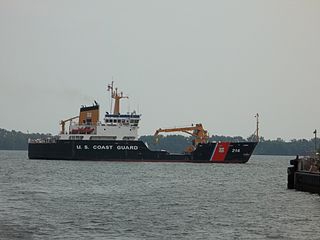
USCGC Hollyhock (WLB-214) is a 225-foot (69 m) Juniper-class cutter of the United States Coast Guard.

Montrealais was a lake freighter launched in 1961. Constructed in two parts, the vessel was completed in 1962 and registered in Canada. Utilized as a bulk carrier, the vessel served on the Great Lakes until 2015. Montrealais was sold three times between 1962 and 2012, when the freighter was acquired by Algoma Central Corp. and renamed Algoma Montrealais. The bulk carrier continued in service until 2015, when the vessel was renamed Mont and sold for scrap. Mont was taken to Aliağa, Turkey and broken up beginning on 10 July 2015.

MV Tim S. Dool is an Algoma Central-owned seawaymax lake freighter built in 1967, by the Saint John Shipbuilding and Dry Dock Co. in Saint John, New Brunswick. She initially entered service as Senneville when she sailed as part of the fleet of Mohawk Navigation Company. Senneville was the second lake freighter constructed with a single superstructure at the stern. In 1981, the ship was sold to Pioneer Shipping. That company sold the vessel to Algoma Central in 1994 who renamed the ship Algoville. The bulk carrier got her current name in 2008. Tim S. Dool is currently in active service on the Great Lakes of North America.

MV Canadian Miner was a Canadian laker that was part of the fleet of Upper Lakes Shipping from 1994–2011. Initially constructed as Maplecliffe Hall in 1966, the ship was renamed Lemoyne in 1988 before becoming Canadian Miner in 1994. In 2011, the name was shortened to just Miner. In 2011 the vessel was taken out of service and sold for scrapping. While en route to the scrapyard in Turkey, the ship ran aground off Nova Scotia in 2011. The vessel was broken up in 2014 in Nova Scotia.

The lake freighter MV Saginaw was launched as John J. Boland in 1953, the third vessel to bear that name. John J. Boland was owned and operated by the American Steamship Company and constructed by Manitowoc Shipbuilding Company at Manitowoc, Wisconsin. In 1999, the ship was sold to Lower Lakes Towing and renamed Saginaw. The ship is currently in service.
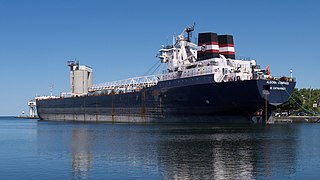
Algoma Compass, formerly Roger M. Kyes and Adam E. Cornelius, is a self-unloading bulk carrier built in Toledo, Ohio in 1973 for the American Steamship Company. The bulk carrier carried bulk cargoes throughout the Great Lakes and St. Lawrence Seaway. The vessel has earned a reputation as a "hard luck" ship, experiencing mechanical failures and groundings. In 2018, the ship was acquired by Algoma Central and put in service as Algoma Compass.

MV John J. Boland is a diesel-powered lake freighter owned and operated by the Buffalo-based American Steamship Company (ASC), a subsidiary of Rand Logistics. This vessel was built in 1973 at Bay Shipbuilding Company, Sturgeon Bay, Wisconsin. Initially named Charles E. Wilson, the vessel was renamed to its current name in 2000.

MV James R. Barker is an American bulk carrier that operates on the upper four North American Great Lakes. Built in 1976 by the American Ship Building Company at Lorain, Ohio, the ship is 1,004 feet (306 m) long, 50 feet (15 m) high and 105 feet (32 m) wide. Like the MV Mesabi Miner, a ship of the same design, it is owned and operated by the Interlake Steamship Company and was named for Interlake’s Chairman of the Board, James R. Barker.
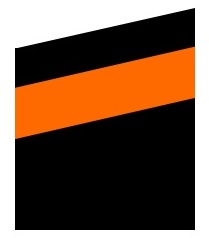
The Interlake Steamship Company is an American freight ship company that operates a fleet on the Great Lakes in North America. It is now part of Interlake Maritime Services.

Algosoo was a lake freighter constructed for Algoma Central in 1974 by Collingwood Shipyard in Collingwood, Ontario. The second ship of the name, Algosoo was the last lake freighter built in the traditional design for use on the North American Great Lakes, where the bridge topped a superstructure right in the ship's bow, and a second superstructure topped her engines, right in the stern. The vessel was used to transport bulk cargoes between ports on the Great Lakes. In 1986, the ship suffered a serious fire and 1994, was forced to run aground. Algosoo transported her last cargo in late 2015 and was sailed to the breaking yard at Port Colborne, Ontario in October 2016.
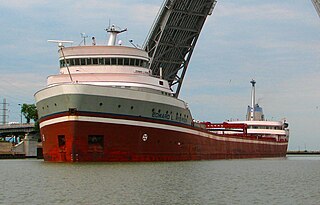
SS Edward L. Ryerson is a steel-hulled American Great Lakes freighter that entered service in 1960. Built between April 1959 and January 1960 for the Inland Steel Company, she was the third of the thirteen so-called 730-class of lake freighters, each of which shared the unofficial title of "Queen of the Lakes", as a result of their record-breaking length. She was not only the last steam-powered freighter built on the lakes but also the last one that was not a self-unloader. Since 2009, she has been in long-term layup in Superior, Wisconsin. She is one of only two American-owned straight deck lake freighters, the other being John Sherwin, built in 1958.

The SS Alpena is a lake freighter. She was built in 1942 by the Great Lakes Engineering Works in Ecorse, Michigan, to carry iron ore. She was originally owned by the Pittsburgh Steamship Company, a subsidiary of United States Steel. After also hauling grain in addition to ore in the 1960s and 1970s, the ship was put into storage in 1982.

USCGC Bristol Bay (WTGB-102) is the second vessel of the Bay-class tugboats built in 1978 and operated by the United States Coast Guard. The ship was named after the body of water formed by the Alaskan peninsula, which emptied into the Bering Sea.




















